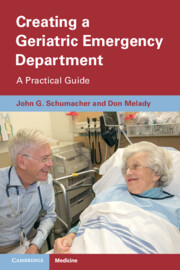Book contents
- Creating a Geriatric Emergency Department
- Creating a Geriatric Emergency Department
- Copyright page
- Dedication
- Contents
- Acknowledgments
- Introduction
- Chapter 1 Making the Case for a Geriatric Emergency Department
- Chapter 2 Starting a Geriatric Emergency Department
- Chapter 3 Overcoming Resistance: What to Do with “Yeah, But…”
- Chapter 4 You: An Approach to Your Older Emergency Department Patients
- Chapter 5 People: Adding Staffing and Training
- Chapter 6 Processes: Implementing Protocols and Policies
- Chapter 7 Place: Addressing the Physical Environment
- Chapter 8 Quality Improvement in the Geriatric Emergency Department: Getting Started
- Chapter 9 Launching Your Geriatric Emergency Department: From First Steps to Accreditation
- Appendix: Practical Resources and Links
- Index
- References
Chapter 6 - Processes: Implementing Protocols and Policies
Published online by Cambridge University Press: 20 January 2022
- Creating a Geriatric Emergency Department
- Creating a Geriatric Emergency Department
- Copyright page
- Dedication
- Contents
- Acknowledgments
- Introduction
- Chapter 1 Making the Case for a Geriatric Emergency Department
- Chapter 2 Starting a Geriatric Emergency Department
- Chapter 3 Overcoming Resistance: What to Do with “Yeah, But…”
- Chapter 4 You: An Approach to Your Older Emergency Department Patients
- Chapter 5 People: Adding Staffing and Training
- Chapter 6 Processes: Implementing Protocols and Policies
- Chapter 7 Place: Addressing the Physical Environment
- Chapter 8 Quality Improvement in the Geriatric Emergency Department: Getting Started
- Chapter 9 Launching Your Geriatric Emergency Department: From First Steps to Accreditation
- Appendix: Practical Resources and Links
- Index
- References
Summary
Defines protocol, policy, and process and their importance in creating the Geriatric ED. Presents nearly 30 different processes that you can adopt or adapt to move towards geriatric-focussed ED care. Screening; enhanced assessments; workflow changes; transitions of care; physical comfort. Encourages EDs to consider which are going to be both easiest to implement and which are going be highest impact.
Keywords
- Type
- Chapter
- Information
- Creating a Geriatric Emergency DepartmentA Practical Guide, pp. 63 - 87Publisher: Cambridge University PressPrint publication year: 2022

